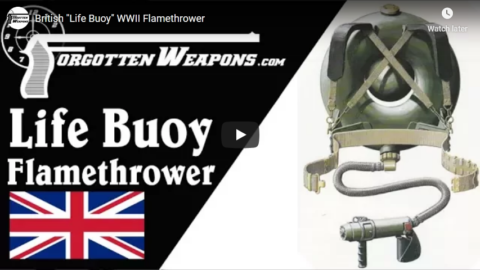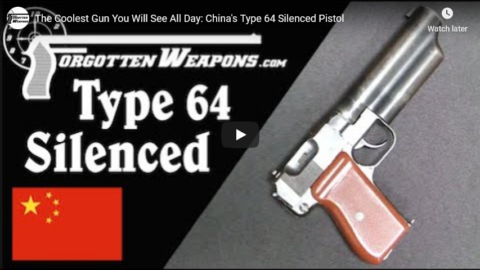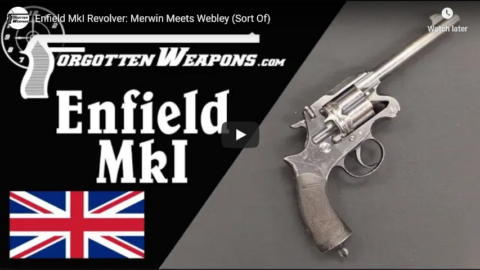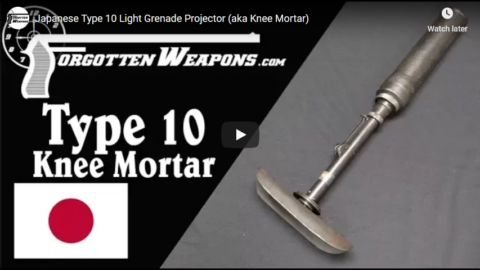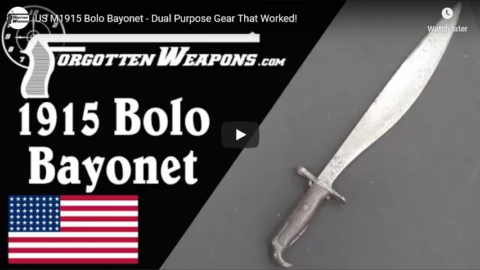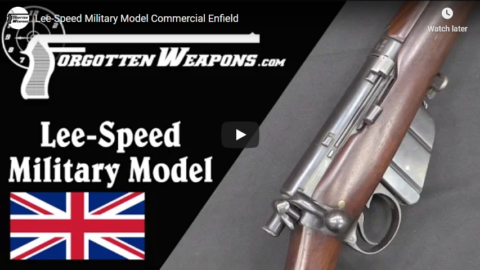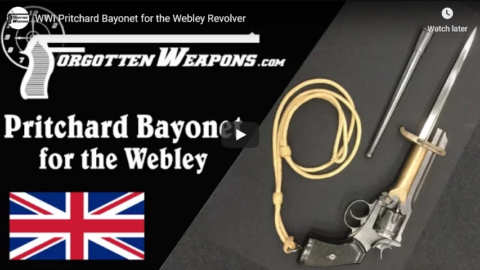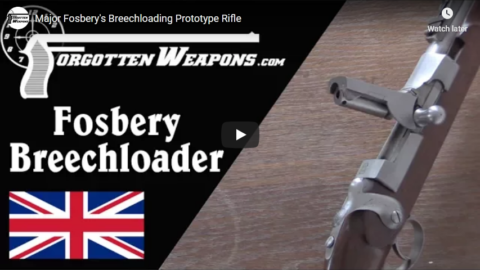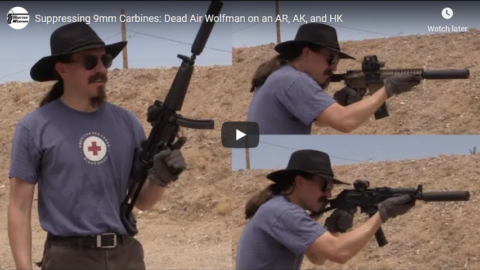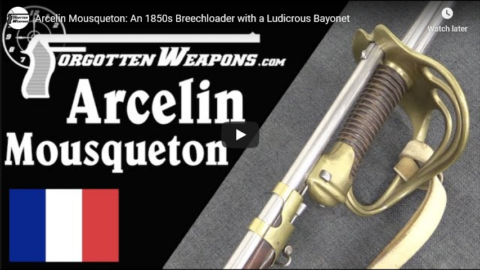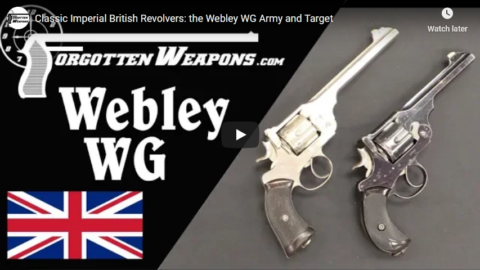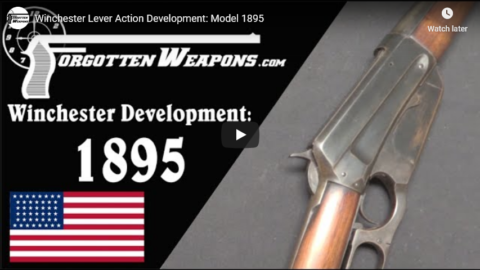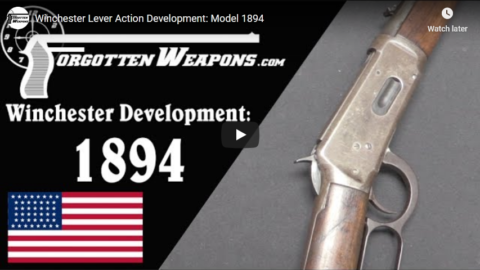Forgotten Weapons
Published 3 Oct 2017http://www.patreon.com/ForgottenWeapons
One of the the flamethrower design styles to come out of experimentation late in World War One was the toroid type, with a donut-shaped fuel tank and a central spherical pressure bottle. The British continued development on this type of weapon between the wars, and used it in World War Two. While the early models used a hydrogen spark ignition system, this was replaced in 1942 by a cartridge flare system like the US and Japanese models.
The tank on this example is a fiberglass one, and very lightweight. This was introduced after World War Two, and this one is an experimental model.
Armament Research Services (ARES) is a specialist technical intelligence consultancy, offering expertise and analysis to a range of government and non-government entities in the arms and munitions field. For detailed photos of the guns in this video, don’t miss the ARES companion blog post:
Cool Forgotten Weapons merch! http://shop.bbtv.com/collections/forg…
If you enjoy Forgotten Weapons, check out its sister channel, InRangeTV! http://www.youtube.com/InRangeTVShow
December 2, 2020
British “Life Buoy” WWII Flamethrower
December 1, 2020
Pattern 14 MKI W (T) – The Best Sniper Rifle of World War One
Forgotten Weapons
Published 30 Aug 2017When World War One began, the British did not have a formal sniping program, and by 1915 the British found themselves thoroughly outclassed by the Germans in this area. They responded by developing tactics and equipment for sniping, and by mid 1916 they had really outclassed the Germans. However, the mid-war British sniping rifles really left a lot to be desired, even if they were being used effectively in the field. There was no single military optic, instead a wide variety of commercial scopes were rounded up and put into use. The mounts for these scopes were offset to the left side of the rifles to allow for continued use of stripper clips. Clips were arguably not really necessary on these rifles, and the offset scopes led to substantial headaches in use, as they required calculating windage as well as elevation adjustments depending on range.
Through 1918, though, the British developed one of the best sniping rifles of the war, although it would be introduced too late to see virtually any front line service. This new rifle was a Winchester-made Pattern 1914 Enfield with a center-mounted optic, and was designated the P14 MkI W(T). The P14 rifles were more accurate than the SMLE, and the centrally mounted optic made for much simpler shooting. These rifles were deemed to be mechanically capable of 1.5 MOA shooting, with the practical expected group size being 3 MOA.
Three thousand of these P14 snipers’ rifles were assembled and kept in service after the end of the war, but in the mid 1930s a small additional batch of 79 were made for the Irish Free State by BSA. These were all eventually surplussed to the US, and the rifle in this video is one of those late-production guns.
http://www.patreon.com/ForgottenWeapons
Cool Forgotten Weapons merch! http://shop.bbtv.com/collections/forg…
If you enjoy Forgotten Weapons, check out its sister channel, InRangeTV! http://www.youtube.com/InRangeTVShow
November 28, 2020
FN Model D: The Last and Best BAR
Forgotten Weapons
Published 21 Aug 2020http://www.patreon.com/ForgottenWeapons
https://www.floatplane.com/channel/Fo…
Cool Forgotten Weapons merch! http://shop.bbtv.com/collections/forg…
Contact:
Forgotten Weapons
6281 N. Oracle #36270
Tucson, AZ 85740
November 25, 2020
The Coolest Gun You Will See All Day: China’s Type 64 Silenced Pistol
Forgotten Weapons
Published 14 Aug 2020http://www.patreon.com/ForgottenWeapons
https://www.floatplane.com/channel/Fo…
Cool Forgotten Weapons merch! http://shop.bbtv.com/collections/forg…
The Type 64 is a dedicated suppressed pistol first introduced in 1965 and used in the Vietnam War. It uses a rimless version of the .32 ACP cartridge (7.65x17mm) in a 9-round Makarov-like magazine. Despite outward similarity to the Makarov (especially the grip), the design is wholly unique internally. It uses basically a miniaturized AK bolt to allow the shooter to select between blowback semiauto functioning and single shot manual operation. The bolt’s rotating locking lugs prevent it from cycling when locked, in a very clever alternative use of the rotating bolt system. The suppressor has two chambers, using a combination of baffles and wire mesh as suppressor elements. In addition to standard ammunition, a plastic-sabot frangible load was also developed for use in situations like airline hijackings, and this loading is why some sources reference a maximum effective range of 15 meters.
For all its technical cleverness, the Type 64 is a rather heavy pistol, at 1.8kg / 4 pounds. It was replaced in 1967 by the substantially lighter and simpler Type 67, which weighed only 1.05kg / 2.3 pounds. This particular Type 64 was originally owned by Mitch Werbell III, giving it an even more interesting history …
Contact:
Forgotten Weapons
6281 N. Oracle #36270
Tucson, AZ 85740
November 22, 2020
Enfield MkI Revolver: Merwin Meets Webley (Sort Of)
Forgotten Weapons
Published 23 Aug 2018http://www.patreon.com/ForgottenWeapons
Cool Forgotten Weapons merch! http://shop.bbtv.com/collections/forg…
Adopted in 1880 to replace the Adams revolver, the Enfield MkI was based on an extraction system patented in the 1870s by Owen Jones of Philadelphia. This was similar in practice to the Merwin & Hulbert, with the barrel and cylinder hinging forward while the cartridge cases were held to the back of the frame. This system allowed empty cases to drop free (except the 6 o’clock position one, which often stuck) while retaining any unfired cartridges in the cylinder. Because the extractor star was fixed to the frame, the piece had to be loaded one round at a time through a loading gate (again, like the Merwin & Hulbert).
In 1882 a number of improvements were made to the design and lockwork, including features to prevent the cylinder from rotating freely and to disconnect the hammer when the loading gate was open. This was adopted as the MkII in 1882. A further change was made in 1887, following the death of a Royal Navy sailor whose gun fell out of its holster and discharged upon hitting the hammer. A new safety mechanism was added to prevent this from happening again, and most guns in service were retrofitted with it.
The Enfield was generally not well received, as it was heavy and a bit awkward to handle. It was issued to the Army, Navy, and RCMP, but replaced by the first adopted Webley top-break revolvers in the late 1880s (Enfield MkII production ceased in 1889). Unlike the Webleys and other private-production guns, there was never a civilian version of the Enfield MkI or MkII made, and they are scarcer to find today as a result.
If you enjoy Forgotten Weapons, check out its sister channel, InRangeTV! http://www.youtube.com/InRangeTVShow
Contact:
Forgotten Weapons
6281 N Oracle #36270
Tucson, AZ 85704
November 19, 2020
Japanese Type 10 Light Grenade Projector (aka Knee Mortar)
Forgotten Weapons
Published 24 Mar 2018In the aftermath of World War One, the Japanese military saw the utility of infantry-portable light grenade launchers instead of rifle grenades, and adopted the Type 10 in 1921 (Taisho 10). It went into production in 1923 at the Tokyo Army Arsenal, although the great Tokyo earthquake led to production being moved to Nagoya, where about 11,000 were made between 1925 and 1937. The Type 10 was a remarkably light and handy weapon, weighing just 5.5lb (2.5kg) and disassembling into a transport configuration the size of a wine bottle.
The larger Type 89 grenade launcher was adopted in 1929, which led to the older Type 10s being relegated to use for illumination and signaling, which they did through the end of World War Two.
http://www.patreon.com/ForgottenWeapons
Cool Forgotten Weapons merch! http://shop.bbtv.com/collections/forg…
If you enjoy Forgotten Weapons, check out its sister channel, InRangeTV! http://www.youtube.com/InRangeTVShow
Contact:
Forgotten Weapons
6281 N Oracle #36270
Tucson, AZ 85704
I posted Ian’s review of the Type 89 here.
November 16, 2020
US M1915 Bolo Bayonet – Dual Purpose Gear That Worked!
Forgotten Weapons
Published 27 Nov 2017The M1915 bolo bayonet was originally the brainchild of US Army Captain Hugh D. Wise, Quartermaster with the 9th Infantry in the Philippines. In 1902, he recommended the implement in a letter to his superior officers, noting that a bolo style of bayonet (ie, one with a widened machete-like blade) would have several advantages over the standard knife bayonet then being issued with the Krag-Jorgenson rifles the US Army was using. Specifically, the wider bayonet would be easier to recover after a thrust (he noted several instances of troopers being killed while trying to extricate their bayonets from enemies) and also (and more significantly) make an excellent and necessary bushwhacking tool in the jungle environment of the Philippines.
Wise’s idea was taken with interest and Springfield produced a series of experimental bolo bayonets, but the project ended there as the 1903 Springfield was adopted with a rod bayonet instead of a blade. Of course, the rod bayonet would be shortlived, and the blade bayonet would come back. The bolo bayonet ideas resurfaced in 1911 when a commission was formed to look into special equipment for the Philippine Scouts. After another series of experimental designs, the M1915 Bolo bayonet was formally adopted on May 22, 1915 and an order was placed for 6,000 of them to be made at Springfield Armory.
Delivery of these bayonets took place in 1915 and 1916, and they proved to be extremely popular tools with the soldiers in the Philippines. They would remain in service on the islands until World War Two, serving at last as a replacement for the M1913 cavalry saber for the 26th Cavalry.
http://www.patreon.com/ForgottenWeapons
Cool Forgotten Weapons merch! http://shop.bbtv.com/collections/forg…
If you enjoy Forgotten Weapons, check out its sister channel, InRangeTV! http://www.youtube.com/InRangeTVShow
November 13, 2020
Lee-Speed Military Model Commercial Enfield
Forgotten Weapons
Published 27 Jan 2017In 1892, just a few years after the British military adopted the Lee-Metford rifle, the BSA and LSA factories began offering several configurations on the civilian/commercial market. They would produce them all the way into the 1930s, with your choice of Metford or Enfield rifling, and in Sporting, Trade, or Military/Target configurations. The Lee-Speed name comes from the patents used in the rifles — James Paris Lee for the magazine, and Joseph Speed for several improvements to the bolt and magazine. Speed was an employee of the Royal Small Arms Factory at Enfield, and was instrumental in the development and adoption of the Lee rifles.
This particular example is a Military/Target rifle, of the Lee-Enfield MkII pattern. Note the safety lever on the cocking piece, the Martini style rear sight, and the magazine chained to the trigger guard assembly. When they haven’t been sporterized, the Lee-Speed military pattern rifles are a great time capsule of British rifle design. Military rifles were generally updated as new patterns were adopted, while these civilian guns were not.
http://www.patreon.com/ForgottenWeapons
Cool Forgotten Weapons merch! http://shop.bbtv.com/collections/forg…
If you enjoy Forgotten Weapons, check out its sister channel, InRangeTV! http://www.youtube.com/InRangeTVShow
November 10, 2020
WWI Pritchard Bayonet for the Webley Revolver
Forgotten Weapons
Published 23 Nov 2016Cool Forgotten Weapons Merch! http://shop.bbtv.com/collections/forg…
The Pritchard bayonet for the Webley revolver is one of the more photogenic and less truly practical weapons to come out of the Great War. Designed by one Captain Pritchard after he spent a year in France in 1915-1916 with the Royal Berkshire Regiment, the idea was to use the front 8 inches or so of a sword on a cast gunmetal hilt to create a bayonet mounted on a British service revolver. He first presented the idea to the Wilkinson Sword Company, but they were too busy making sabers and rifle bayonets, and suggested that having to sacrifice usable sword blades for production would make it quite the expensive endeavor.
Pritchard next took his idea to W.W. Greener, where he found a more receptive audience. Greener had a large supply of surplus French Gras bayonets, which were cheap and served as excellent donors for the Pritchard bayonets. Something like 200 were made in total — not formally adopted by the British but available for commercial sale to officers who might want them. While some may have seen service, no hard evidence has been found to prove any combat action with them.
Over the decades, a great many fake and reproduction Pritchard bayonets have been made — many times more than there are originals. As far as I can determine, this one is a legitimate original (although it may have a replacement locking lever). A few things to look for in authenticating a Pritchard are engraved patent and manufacturer marks (most reproductions have no manufacturer logo and a stamped patent number) and a quality casting. When you hold the blade and tap the handle with a hard object, it should ring bright and bell-like (which this one does).
November 7, 2020
Major Fosbery’s Breechloading Prototype Rifle
Forgotten Weapons
Published 5 Aug 2017http://www.patreon.com/ForgottenWeapons
Cool Forgotten Weapons merch! http://shop.bbtv.com/collections/forg…
George Fosbery was the British officer (Major, at the time of this particular design) responsible for the quite famous Webley-Fosbery self-cocking revolver, as well as the Paradox system for shotgun slugs and many other lesser known firearms inventions. This rifle was his entry into British trials in the late 1860s for a cartridge firing rifle. Ultimately the Martini-Henry would be chosen, but nine different guns were put through testing including Fosbery’s.
One of the aspects that Fosbery’s design was particularly well suited for was the requirement that the gun be able to be loaded with a minimum amount of movement required that might interfere with men standing in close formation. Despite this, Fosbery only managed to come in 6th place in the trials, and only a small number of his guns were sold on the civilian market afterwards.
If you enjoy Forgotten Weapons, check out its sister channel, InRangeTV! http://www.youtube.com/InRangeTVShow
November 4, 2020
Suppressing 9mm Carbines: Dead Air Wolfman on an AR, AK, and HK
Forgotten Weapons
Published 25 Jul 2020http://www.patreon.com/ForgottenWeapons
https://www.floatplane.com/channel/Fo…
Cool Forgotten Weapons merch! http://shop.bbtv.com/collections/forg…
Contact:
Forgotten Weapons
6281 N. Oracle #36270
Tucson, AZ 85740
From the comments:
ArfurFaulkesHake
44 minutes ago (edited)
It’s a shame that we can’t really hear how quiet this suppressor actually is, since the normalisation of the microphone doesn’t transmit how earshatteringly loud a normal shot is. But the fact that I could hear the bullets ricochet of the targets (4:01) speaks volumes about how good this suppressor is.
November 1, 2020
Arcelin Mousqueton: An 1850s Breechloader with a Ludicrous Bayonet
Forgotten Weapons
Published 26 Jun 2020http://www.patreon.com/ForgottenWeapons
https://www.floatplane.com/channel/Fo…
Cool Forgotten Weapons merch! http://shop.bbtv.com/collections/forg…
The Arcelin system was a capping breechloader provisionally adopted by the French military in 1854. It was a bolt action system with a folding bolt handle, firing a paper cartridge. It impressed Emperor Louis Napoleon III in initial trials, and he directed it be used to arm his elite Cent Gardes bodyguard. More extensive testing showed that it suffered from insufficient obturation, and would with extended use, eventually become so difficult to close that bolt handles would break. Its adoption was rescinded, and it was replaced by the Treuille de Beaulieu 9mm pinfire carbine in Cent Gardes use within just a few years.
The most distinctive element of the Arcelin in use was its bayonet — a true full-length sword complete with brass handguard that could be clipped to the muzzle. This was chosen for its impressive length, although it would have been cumbersome if used beyond ceremonial guard duties.
Thanks to the Cody Firearms Museum for allowing me access to film this very rare and very cool musketoon and its bayonet! Check them out here: https://centerofthewest.org/explore/f…
Contact:
Forgotten Weapons
6281 N. Oracle #36270
Tucson, AZ 85740
October 26, 2020
Classic Imperial British Revolvers: the Webley WG Army and Target
Forgotten Weapons
Published 19 Aug 2018http://www.patreon.com/ForgottenWeapons
Cool Forgotten Weapons merch! http://shop.bbtv.com/collections/forg…
The Webley company used the “WG” (Webley Government) nomenclature in its literature starting in 1883, but the first revolver actually marketed as such was the WG Model of 1889. These revolvers were made primarily for the military market, as officers were responsible for supplying their own sidearms in the British military until 1915. The WG was a full size service revolver in .455 caliber (accepting a wide variety of .45 inch British cartridges, including the .450, .455, .476, Enfield Mk II, and Enfield MkIII). A series of refinements would be made to the design culminating in the generally-accepted standard WG pattern in 1896. These would be produced until 1902, when they were replaced by the Webley WS (Webley Service).
The two main variation of the WG were the Army and the Target. The Army typically had a bird’s-head grip and a 6 inch barrel, where the Target had a longer 7.5 inch barrel and a flared square-butt grip, as well as adjustable sights. However, Webley was happy to supply and mix of features to a customer, and many branded patterns exist. The Target pattern proved very successful for shooters at the Dublin, Glasgow, and Wimbledon matches of the period. A total of about 22,000 WG pattern revolvers were made, with the “standard” 1896 model appearing around s/n 10,000.
Contact:
Forgotten Weapons
6281 N Oracle #36270
Tucson, AZ 85704
October 22, 2020
Winchester Lever Action Development: Model 1895
Forgotten Weapons
Published 19 Jun 2017We have reached the final iteration of the Winchester lever action rifle development story today, the Model 1895. This was another John Browning design, although the locking system is basically the same as the 1894 but with the bolt extending over the top of the locking block and hiding it from sight.
The new feature of the Model 1895 was the replacement of the traditional tube magazine with a single stack box magazine located under the action. By this time, spitzer (pointed) bullets were becoming commonplace, to exploit the new high velocities made possible by the new smokeless powders. In a tubular magazine, these pointed bullets would rest on the primer of the next cartridge in the magazine, and ran the risk of causing rounds to detonate in the magazine tube under recoil. The box magazine, of course, negated this danger completely.
The Model 1895 was built around the .30-40 military cartridge, although was initially released in two black powder chamberings. It would eventually be offered in a wide variety of chamberings, including .30-03, .30-06, .303 British, and the .405 Winchester — Theodore Roosevelt’s “Big Medicine”. In addition, more than half of the total production (nearly 300,000 rifles) would be for the Russian military, with the rifles chambered for 7.62x54R and fitted with stripper clip guides.
Cool Forgotten Weapons merchandise! http://shop.bbtv.com/collections/forg…
http://www.patreon.com/ForgottenWeapons
If you enjoy Forgotten Weapons, check out its sister channel, InRangeTV! http://www.youtube.com/InRangeTVShow
October 20, 2020
Winchester Lever Action Development: Model 1894
Forgotten Weapons
Published 17 Jun 2017The Winchester 1894 has become one of the most manufactured and most popular sporting rifles in American history, and it owes this success to a combination of factors. Mechanically, the 1894 was a continued improvement on John Browning’s already-excellent 1892 model. It was strong and simple to operate, offering both speed and power. The cartridge that cannot be separated from the history of the Winchester 94 is the .30-30 Winchester, aka the .30 WCF (Winchester Center Fire).
While the .30-30 shared a naming convention with the many black powder rounds that were in use (a .30 caliber bullet over 30 grains of powder), this new round was a smokeless powder cartridge. As such, it offered a very significant increase in velocity over everything else that was then available (just shy of 2000 fps). The cartridge was well suited for taking nearly any North American game, and the package of the 94 and the .30-30 made an outstanding general purpose weapon for a huge swathe of the American market.
By 1927, one million had been manufactured (the millionth one was presented to President Coolidge), and by 2006 production had exceeded 7 million. This truly is the iconic American deer and ranch rifle — so ubiquitous that its remarkable quality has set a new standard for the entire industry.
Cool Forgotten Weapons merchandise! http://shop.bbtv.com/collections/forg…
http://www.patreon.com/ForgottenWeapons
If you enjoy Forgotten Weapons, check out its sister channel, InRangeTV! http://www.youtube.com/InRangeTVShow

